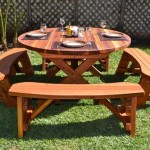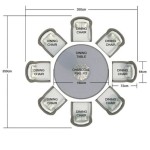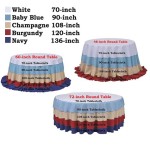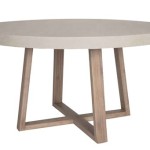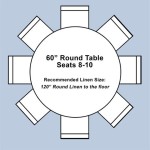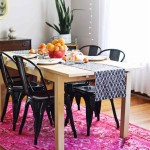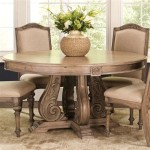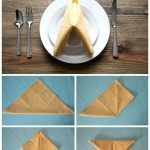How to Measure Your Table for a Tablecloth
Selecting the appropriate tablecloth size is essential for both aesthetic appeal and practical functionality. A properly sized tablecloth enhances the dining experience, protects the table surface, and contributes to the overall ambiance of a room. Accurately measuring the table before purchasing a tablecloth ensures a correct fit, preventing issues such as a tablecloth that is too short, exposing the table, or one that is excessively long, posing a tripping hazard. The process involves considering the table's shape, dimensions, and the desired drop length, factoring in any embellishments or special features of the table.
Ignoring the measurement process can result in a mismatch between the tablecloth and the table, leading to visual disharmony and inconvenience. A tablecloth that is too small will not provide adequate protection, while an oversized one can appear sloppy and cumbersome. Therefore, taking precise measurements is a fundamental step in selecting the ideal tablecloth for a particular table.
This article provides a comprehensive guide to measuring various table shapes and determining the appropriate tablecloth size. It outlines the necessary steps, tools, and considerations for achieving a perfect fit, ensuring that the chosen tablecloth complements the table and enhances the dining environment.
Before commencing the measurement process, certain essential tools are required. A flexible measuring tape is paramount for accurately determining the table's dimensions. Cloth measuring tapes are generally more pliable and conform better to curved surfaces compared to rigid metal tapes. A notepad and pen are also necessary for recording the measurements and calculations. A calculator may be helpful when calculating the finished tablecloth size, particularly when working with drop lengths. Finally, a basic understanding of geometric shapes and their associated formulas will aid in measuring irregularly shaped tables.
1. Measuring Rectangular and Square Tables
Rectangular and square tables are among the most common types encountered in residential and commercial settings. Measuring these tables is relatively straightforward, involving the determination of their length and width. Accuracy is crucial in obtaining precise measurements for a well-fitting tablecloth.
To begin, use the measuring tape to measure the length of the table, extending from one end to the other. Record this measurement in the notepad. Next, measure the width of the table, spanning from one side to the other. Again, record this measurement. Ensure that the measuring tape is held taut and straight to minimize errors. For example, if the table is 60 inches long and 40 inches wide, these figures will form the basis for subsequent calculations. These base measurements do not include the drop length yet.
The drop length refers to the distance the tablecloth hangs down from the edge of the table. The desired drop length is largely a matter of personal preference and the formality of the setting. For casual settings, a drop length of 8 to 12 inches is generally suitable. For more formal occasions, a drop length of 15 to 30 inches is more appropriate. A longer drop creates a more elegant and sophisticated appearance.
To determine the finished tablecloth size, the desired drop length must be added to both the length and width measurements. For instance, if a 10-inch drop is desired for a table that is 60 inches long and 40 inches wide, the calculation would be as follows: Tablecloth Length = Table Length + (Drop Length x 2) = 60 inches + (10 inches x 2) = 80 inches. Tablecloth Width = Table Width + (Drop Length x 2) = 40 inches + (10 inches x 2) = 60 inches. In this scenario, an 80-inch by 60-inch tablecloth would be the correct size.
When selecting a tablecloth, it is always advisable to slightly round up to the nearest standard tablecloth size. This provides a margin of error and ensures that the tablecloth is sufficiently large to accommodate the table. It is generally easier to manage a slightly oversized tablecloth than one that is too small to adequately cover the table.
2. Measuring Round Tables
Round tables present a slightly different challenge compared to rectangular and square tables. The primary measurement required for a round table is its diameter. The diameter is the distance across the table, passing through the center point.
To measure the diameter, position the measuring tape so that it extends from one edge of the table, through the center, to the opposite edge. Ensure that the measuring tape passes directly through the center to obtain the most accurate measurement. This can be approximated by visually aligning the tape. Record the diameter measurement in the notepad.
As with rectangular and square tables, the desired drop length must be considered when determining the finished tablecloth size. The drop length is the distance the tablecloth will hang down from the edge of the table. The same considerations regarding formality and personal preference apply when selecting the drop length for a round table.
To calculate the finished tablecloth diameter, add twice the desired drop length to the table diameter. For example, if a round table has a diameter of 48 inches and a 12-inch drop is desired, the calculation would be: Tablecloth Diameter = Table Diameter + (Drop Length x 2) = 48 inches + (12 inches x 2) = 72 inches. Therefore, a 72-inch round tablecloth would be the appropriate size.
Available tablecloth sizes for round tables typically come in standard increments. When selecting a tablecloth, it is beneficial to choose the closest standard size that is equal to or slightly larger than the calculated diameter. This ensures that the tablecloth adequately covers the table and provides the desired drop length.
3. Measuring Oval and Other Irregularly Shaped Tables
Oval and other irregularly shaped tables require a more nuanced approach to measurement. These tables lack the consistent dimensions of rectangular, square, and round tables, necessitating multiple measurements to determine the appropriate tablecloth size.
For oval tables, the key measurements are the length (the longest dimension) and the width (the widest dimension perpendicular to the length). Measure the length of the oval table at its longest point, and record this measurement. Then, measure the width of the oval table at its widest point, ensuring that this measurement is taken perpendicular to the length. Record this measurement as well.
Once the length and width have been measured, the desired drop length must be added to each dimension, as with rectangular tables. Calculate the finished tablecloth length and width by adding twice the desired drop length to the respective measurements. For example, if an oval table is 70 inches long and 50 inches wide, and a 15-inch drop is desired, the calculation would be: Tablecloth Length = Table Length + (Drop Length x 2) = 70 inches + (15 inches x 2) = 100 inches. Tablecloth Width = Table Width + (Drop Length x 2) = 50 inches + (15 inches x 2) = 80 inches. Therefore, a 100-inch by 80-inch tablecloth would be appropriate for this oval table.
For tables with other irregular shapes, the process involves measuring the longest and widest dimensions of the table. This may require taking multiple measurements at different points to identify the maximum length and width. Once these dimensions are determined, the calculations for the finished tablecloth size are performed in the same manner as for oval and rectangular tables, adding twice the desired drop length to each dimension.
When selecting a tablecloth for an irregularly shaped table, consider the overall shape and how the tablecloth will drape. It may be necessary to select a tablecloth that is slightly larger than the calculated dimensions to ensure adequate coverage. In some cases, a custom-made tablecloth may be the best option for achieving a perfect fit for unusually shaped tables.
In addition to the table's dimensions and the desired drop length, other factors can influence the choice of tablecloth size. The thickness of the tabletop can add slightly to the measurements, particularly if the table has a thick edge or embellishments. A padded table protector can also affect the required tablecloth size, as it adds to the overall thickness.
The type of fabric used for the tablecloth can also play a role. Natural fibers, such as cotton and linen, are prone to some shrinkage after washing, so it is advisable to allow for this shrinkage when determining the tablecloth size. Synthetic fabrics, such as polyester, are generally less prone to shrinkage and may not require the same allowance.
Finally, the intended use of the tablecloth should be considered. For everyday use, a tablecloth that is easy to clean and maintain is desirable. For formal occasions, a more luxurious fabric and a longer drop length may be preferred. Understanding these factors and taking them into account during the measurement process will ensure that the chosen tablecloth is both functional and aesthetically pleasing.

How To Measure Your Table For A Tablecloth Wipe Away Tablecloths

Tablecloth Size Calculator Williams Sonoma Taste

3 Easy Ways To Measure Tablecloth Sizes Your Table Linens Size Guide

How To Choose Tablecloths Understanding Correct Measurements Your Chair Covers Inc

What Size Tablecloth Do I Need Deconovo Us

Measuring Yardage For A Tablecloth Ofs Maker S Mill

How To Choose The Correct Size Tablecloth For Your Table

How To Choose The Correct Size Tablecloth For Your Table

How To Measure For A Tablecloth 2 Easy Methods

How To Measure A Table For Tablecloth Only Follow These Steps
Related Posts

